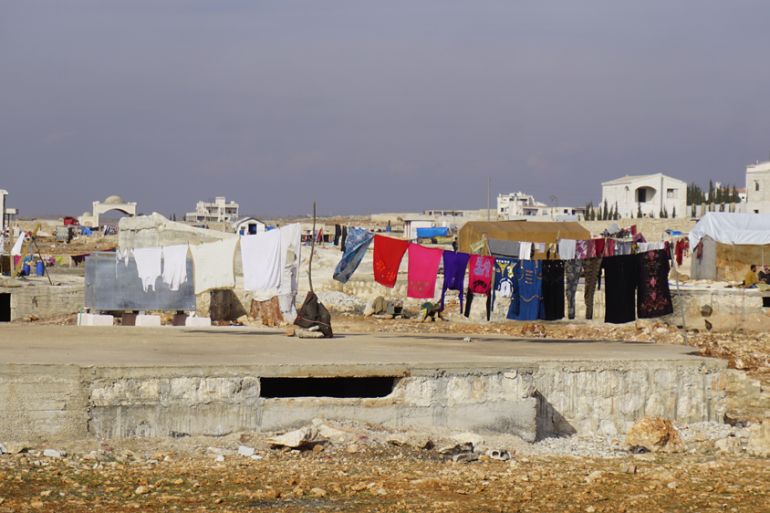Syrians continue to flee despite ceasefire
Al-Junairi camp in northwestern Syria has been receiving newcomers on a daily basis, straining aid delivery.

Near Arum, Syria – Five months ago, Mohammad Khamis, a 14-year-old boy from a small village in southern Syria, lost his leg in an aerial bombing carried out by forces loyal to Syrian President Bashar al-Assad.
His family later drove to the al-Junairi camp in the country’s northwest to escape the violence in their home village. But Khamis does not like his life in the camp, and misses school. “There is nothing … I just sit outside the tent and watch the kids playing around me,” he told Al Jazeera.
Keep reading
list of 4 items‘Mama we’re dying’: Only able to hear her kids in Gaza in their final days
Europe pledges to boost aid to Sudan on unwelcome war anniversary
Birth, death, escape: Three women’s struggle through Sudan’s war
Junairi camp, which sits on a barren plot of land in Aleppo governorate, hosts about 1,500 internally displaced persons who were forced to flee their homes because of Syria’s five-year-old civil war. Most of the camp’s residents, who come from across Syria, live with their families in tents and other makeshift homes, both above ground and underground.
Residents of the camp complain that water and electricity is lacking. “Living conditions here are difficult, as drinking water in particular is sparse,” said Ahmad Rabea, who is from western Syria. Electricity is only on for four hours a day, Khamis added.
READ MORE: Syrian civil war – Hundreds renew ‘pledge’ to oust Assad
Compounding these problems, the camp’s resources are being strained by newcomers. Many of those interviewed by Al Jazeera have arrived at the camp within the past four months – including Rabea, who first left his home in 2011 when the civil war began, and has since moved to various camps throughout the country in search of better living conditions.
![Aid delivery has become a challenge in many parts of Syria [Zouhir Al Shimale/Al Jazeera]](/wp-content/uploads/2016/03/c25f5be4903c48a9abe4b9c830fa0106_19.jpeg)
The ceasefire that took effect last month sparked hope that hostilities would cease. Dalia al-Awqati, the director of programmes for North Syria with Mercy Corps, noted: “The conflict is less intense [but] there are still attacks on particular areas. We’re hopeful, but it’s too early to tell.”
Junairi camp is somewhat isolated from the brutal fighting that has left more than 250,000 people dead. But despite the limited ceasefire, conflict continues to embroil parts of Syria, including northwestern areas near Junairi. As a result, the camp is likely to keep receiving people every day, placing a strain on its already limited resources.
Inside the camp, residents say they feel more or less safe – at least for the time being. “The security situation is relatively acceptable,” Rabea told Al Jazeera. “There are bombings near the camp, but no injuries among the population so far.”
Rabea and others said the Free Syrian Army controls the area around the camp, while aid organisations, both local and foreign, provide water and electricity.
“Sometimes local councils from Arum give us [food] aid,” said Um Ammar, a woman in her fifties who requested that her full name not be used.
Faisal Ghanam, 53, who arrived at the camp three months ago with his three children, said residents receive aid from Mercy Corps every month, including blankets and other winter supplies that can be picked up in nearby Arum. Delivering aid in war-torn Syria is difficult, though, and Junairi residents note that help does not always arrive when it is needed.
“Recent escalations have made it harder in certain locations [to deliver aid and services],” Awqati said, noting that the population of northern Aleppo governorate doubled in less than two weeks because of a government offensive on rebel-held areas of the city in early February.
UPFRONT: Has the world betrayed Syria?
Despite the challenges, Mercy Corps has been working to deliver aid and services to displaced Syrians in the area. “We provide water and sanitation services, non-food items, and new-arrival/hygiene kits that cover all their food needs for two weeks,” Awqati said.

According to the Internal Displacement Monitoring Centre, which is part of the Norwegian Refugee Council, at least 6.6 million people were displaced within Syria as of December 2015 – and most of those displaced in 2015 had already been forced to flee a previous time.
Ghanam said he came to Junairi rather than seeking refuge abroad because he refuses to leave his beloved Syria.
“Of course I don’t want to leave my country. On the contrary, I want to return to my village,” he said, noting he fled his village because of frequent clashes and bombings. “The men and youth should stay in their homeland and defend it. If the youth go, who will stay?”